Analyzing Stranger Things Using James Cameron’s Story of Science Fiction
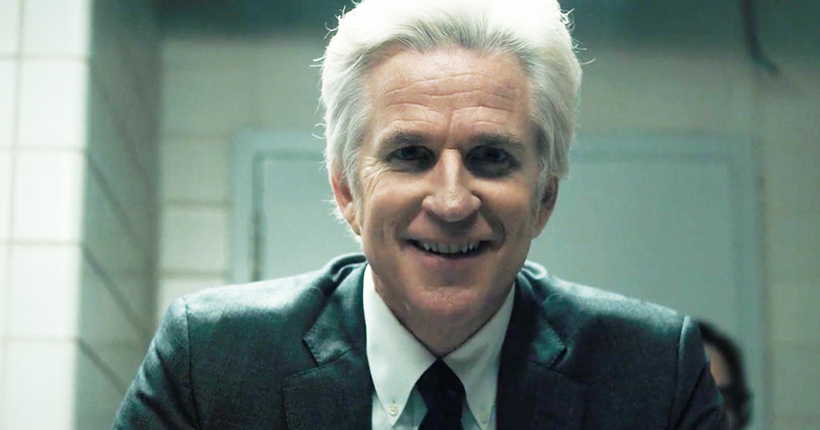
In April and May 2018, AMC broadcasted James Cameron’s Story of Science Fiction, a six episode limited series dedicated to exploring some of the core themes of science fiction literature, television, and film. Anchored by iconic director James Cameron (Terminator, Aliens, Avatar), the show explores six overarching themes within science fiction including aliens, space, monsters, dystopian futures, intelligent machines, and time travel. Along with Cameron’s insightful commentary, the show included dialogue and insight from a variety of actors, directors, writers, designers, and critics. The diverse interviewees were able to offer insight into some of the most complex themes and ideas within science fiction, providing valuable analysis for science fiction novices as well as more seasoned audiences.
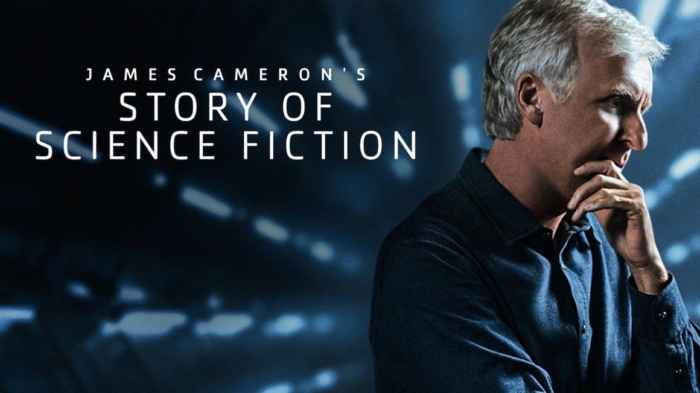
Episode 3 “Monsters” is one of the highlights of the series. The episode includes interview with a variety of key figures within science fiction and horror including Alien’s Ridley Scott, Jurassic Park’s Steven Spielberg and Pacific Rim’s Guillermo del Toro. These three core interview are interwoven with insights from more than a dozen actors, writers, and critics who all offer their unique interpretations and analysis of different science fiction monsters.
While the episode discusses many classic monsters like the terrifying Xenomorph, John Carpenter’s shape-shifting Thing, and the massive Godzilla, the episode appropriately concludes with a discussion of Stranger Things‘s Demogorgon, the most recent addition to the monster pantheon. The instantly iconic Demogorgon debuted in the first season of Stranger Things, proving to be a terrifying adversary for the kids of Hawkins. The bloodthirsty monster acts as a foil for Eleven and an intriguing complement to human antagonist Dr. Martin Brenner. As a scientist, Brenner occupies an important role in the framework and construction of the science fiction monster myth, a tradition that dates back to the origins of science fiction.
With the insight and analysis that is provided by the different interviewees of James Cameron’s Story of Science Fiction, it is apt to reexamine Dr. Martin Brenner, the terrifying Demogorgon, and Eleven. These three characters are clearly influenced by the rich science fiction pantheon that came before them and these inspirations helped inform each character’s arc within the landmark first season of Stranger Things.
A Move From Spiritual Monster To Science Fiction Monsters
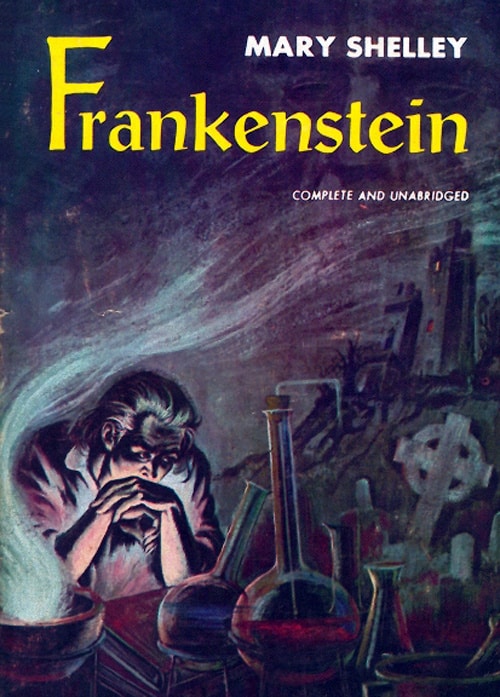 Whether it is the hydras of Greek mythology or the biblical leviathan, monsters have played a key role in the myths and legends of early human beings. With this in mind, it is important to establish a line of demarcation between the traditional monsters of mythology and religion from the science fiction monster.
Whether it is the hydras of Greek mythology or the biblical leviathan, monsters have played a key role in the myths and legends of early human beings. With this in mind, it is important to establish a line of demarcation between the traditional monsters of mythology and religion from the science fiction monster.
In his interview with James Cameron, Guillermo del Toro explores the origins of monsters in human society and how the monster myth was transformed by the emergence of science and science fiction. Del Toro asserts that the earliest monsters in human stories were spiritual, springing from the “belief of good and evil” (Cameron, 158). These horrors were crystallizations of unnatural behaviors or dangers that humanity potentially faced. For example, del Toro discuss how dragons are a composite of the “predators of anthropoids [primates] including the “snake, feline, and large rapacious birds”. In this way, the monster myth warned early humans of the threats of the natural world.
These early monsters are deeply tied to the religious beliefs and ways of life of early society, imparting lesson about how to act and what to fear. For example, Vampires, which exists across a variety of cultures, could represent “possession by an evil spirit…or a suicide” (Cameron, 162). These monsters were also used to articulate the “horrors of the daily life” (169). Story tellers were able to articulate concepts like “dying of cancer, corruption…human disillusionment, war, famine” (169). Monsters were used to symbolize and articulate the blights of life which were often out of the control of early humans.
The origins and role of monster remain consistent until the age of reason and science. While the old monsters never died, a new monster myth emerged as more modern science began to revolutionize the way humans lived and thought. Rather than being spiritually oriented, the monsters now became the byproducts of the experiments and tests of the scientific order. Rather than divine or demonic forces, science became the “anatomy of motor” for the monster (Cameron, 158). Whether it is “radioactivity, genetic engineering, robotics” the new science fiction monsters required a spark of ignition to come into being, a spark that was often provided the figure of the scientist, often label with the somewhat undermining moniker of “mad scientist”.
While classic myths often used human failings and sins as the reason for a monster’s existence, science fiction makes an even clearer effort to connect the origins of a monster as the consequence or side effect of human action. While the goals of a scientist may be to gain a better understanding of nature, science fiction has often represented scientists as men and women who desire to prove that they can do “something that no one else can” (Yaszek, 7: 13) Whether it is classic science fiction novels like Frankenstein and The Strange Case of Dr. Jekyll and Mr. Hyde to iconic films like Jurassic Park, the ramifications of the scientist’s choices and experiments result in the monster. The monster as a symbol of the ramifications of the actions of the scientist is perfectly embodied by Stranger Things‘s Martin Brenner, who is responsible for two distinct monsters.
Dr. Brenner and the Creation of Two Monsters
In Stranger Things, Dr. Martin Brenner plays a key role in the creation of two monsters. Brenner is the driving force behind the secret MKUltra project: a secret cold war era project that is exploring psychic powers without any ethical safeguards or constraints. Actor Matthew Modine portrays Brenner with a calm and understated facade, which is a mask that disguises the character’s chilling cruelty and ruthless ambition. Much like other noted science fiction scientists, Brenner’s experiments are attempts to do something “that no one else can” and these choices have terrible intended and unintended consequences on the people that are involved in the experiment, along with the community of Hawkins as a whole (Yaszek).
In her interview for James Cameron’s Story of Science Fiction, Professor Lisa Yaszek explains that one way to understand the scientist and the monster is to view the monster as a “literal manifestion of the bad actions” of a scientist or humanity as a whole. As Eleven’s backstory is gradually revealed in Stranger Things, the audience can see that Brenner is engaged in activities that are “in violation of the natural order”. Brenner’s violations of nature include more traditionally science fiction experiments like psychic warfare and mind reading, along with real world horrors like the imprisonment and abuse of an adolescent. (Yaszek, 13:52). With Brenner’s treatment of Eleven, the writers of Stranger Things are able to explore some real life horrors that audience might otherwise not “want to admit exist” (Yaszek, 1:03). With monsters and their creators, science fiction stories like Stranger Things can explore horrors both real and imagined.
In an interesting spin on the “monster” tradition, the Demogorgon is a secondary monster, an unintended consequence of Brenner’s true monster: Eleven. It is logical for the audience to view Brenner’s experimentation with Eleven as a form of grotesque transformation. While the young girl is born “Jane” by her mother, she is branded Eleven when she enters the care of Brenner and MKUltra. Brenner’s experiments with Eleven involve intense emotional and physical abuse that often are designed to make Eleven dependent on Brenner, who acts as a twisted parental figure. As the experiment continue, Eleven and the other test subjects become Brenner’s monsters. They are individuals gifted with abilities and powers that are “violations of the natural order”.
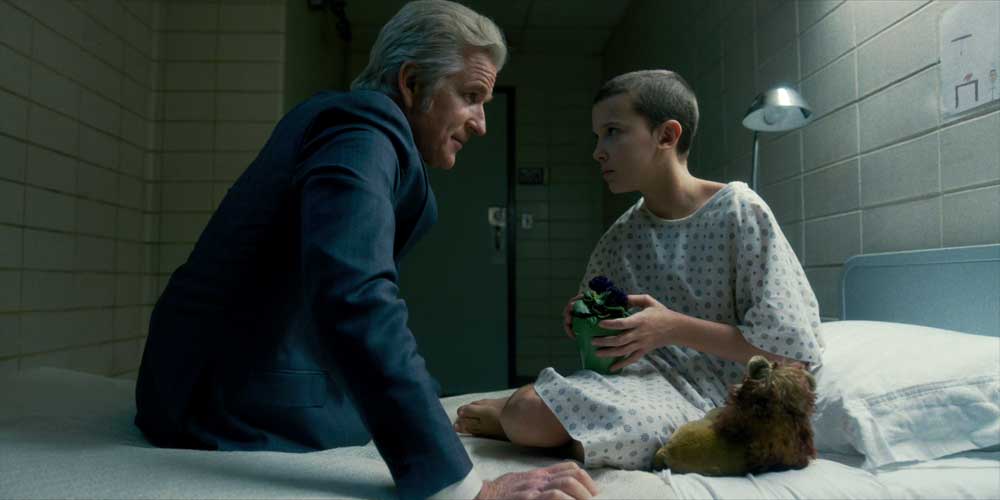 In addition to Eleven’s dangerous and extraordinary powers, Brenner has worked to strip the girl of her identities and natural relationships, stripping her of her humanity. Eleven is kept in a prison-like room with only a single stuffed animal, a stark reminder to the audience of how unnatural Eleven’s upbringing is. The girl’s language and communication skills are largely unused or underdeveloped, leaving the girl at a disadvantage should she ever enter society. Perhaps most importantly, Eleven herself feels like a monster. In Episode 6, Eleven admits to Mike that she is the “monster”, acknowledging her unnatural powers and her mistaken unleashing of the Demogorgon.
In addition to Eleven’s dangerous and extraordinary powers, Brenner has worked to strip the girl of her identities and natural relationships, stripping her of her humanity. Eleven is kept in a prison-like room with only a single stuffed animal, a stark reminder to the audience of how unnatural Eleven’s upbringing is. The girl’s language and communication skills are largely unused or underdeveloped, leaving the girl at a disadvantage should she ever enter society. Perhaps most importantly, Eleven herself feels like a monster. In Episode 6, Eleven admits to Mike that she is the “monster”, acknowledging her unnatural powers and her mistaken unleashing of the Demogorgon.
With this in mind, we can see the Demogorgon as another consequence of Brenner’s violations of nature with Eleven. The scientist and his lab unwittingly unleashes the Demogorgon by pushing Eleven’s psychic abilities to their limits. The scientists ventures into psychic warfare result in the opening of the Upside Down which sets the events of Stranger Things in motion. We can also interpret the Demogorgon as a foil to the young Eleven. The Demogorgon is a true monster, lacking human traits or any trace of mercy for anything it hunts. In some ways, The Demogorgon represent the eventual goal of Brenner’s conditioning with Eleven. Brenner is meticulously stripping Eleven of her humanity, transforming Eleven into the monster he desires. With Eleven and the Demogorgon we can see the consequence of violating the laws and rules of nature and society which result in the creation of monsters.
The Influences and Themes Behind The Demogorgon
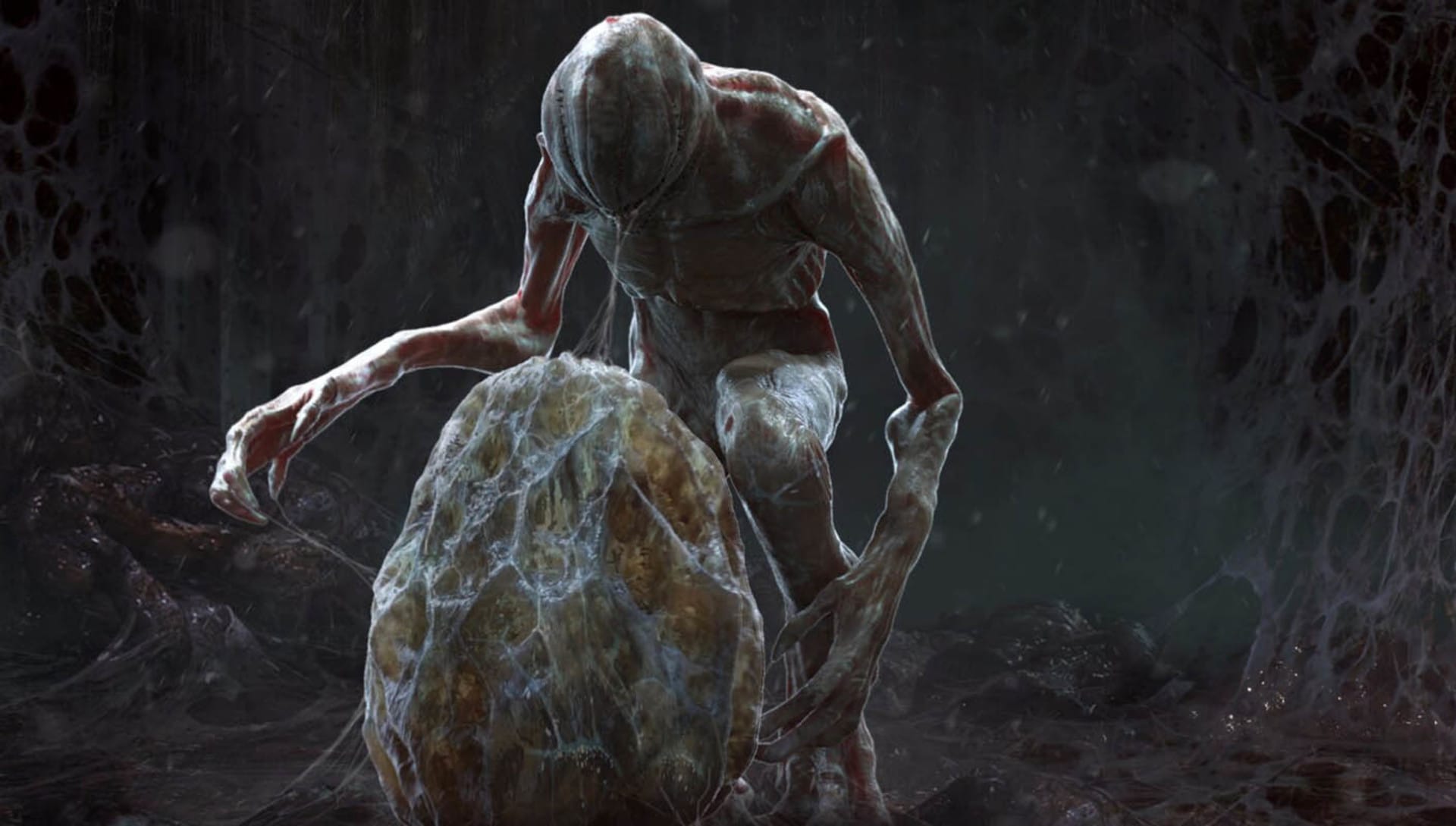
One of the most exciting aspects of James Cameron’s Story of Science Fiction is the opportunity to hear from individuals who had a role in creating the monsters that audiences have had such strong reactions to. Within the discussion of the Demogorgon, concept designer Aaron Sims and creature artist Mark Steger provide behind the scenes insight into the development and construction of the Demogorgon. Sims asserts that the lack a recognizable face gives the creature an unnerving quality, as if it is “something in the shadow” just out of your sight line. Without a recognizable face, the audience is unable to understand “where it’s looking, what it’s thinking” which contributes to the terror inspired by the monster (Sims, 38:24). These qualities along with a pair of classic influences help form the essence of the Demogorgon.
While Stranger Things‘s creators Matt and Ross Duffer have already acknowledged that Steven Spielberg films like Close Encounters of The Third Kind and E.T. the Extra-Terrestrial were a key influence on the show, it’s important to remember that the Demogorgon’s design and aura were also influneced by an iconic Spielberg blockbuster. In James Cameron’s Story of Science Fiction, Mark Steger (creator artist and on set Demogorgon) revealed the instruction he was given as the Duffers discussed how the Demogorgon should move and act. Steger asserted that advice was “concise” and that he was “the Shark from Jaws” (39:10). While the Shark from Jaws was a creature of our world, the Demogorgon was a creature that came from “this other dimension to feed” (39:13).
While the Shark from Jaws informed the movement and identity of the Demogorgon, the influence also manifested within the in-show universe once the cameras rolled. First, Barb Holland is attacked after drops of her blood fall into a pool, summoning the Demogorgon. This moment in which Barb is snatched through the water into the Upside Down recalls the scenes from Jaws where individuals are attacked by the shark. In addition to the Demogorgon’s attack on Barb, Nancy Wheeler compares the Demogorgon to a shark, asserting that both are “drawn by blood”. Nancy and Jonathan use this research on sharks and other predators to create a plan of action against the Demogorgon. In the final episode, Nancy and Jonathan cut their hands in order to summon the Demogorgon, setting off one of the most intense sequences in the show. These two key examples illustrate the influence Jaws had on the Demogorgon which helped shape the new monster into the terror it would become.
 Another key influence on the Demogorgon was the Xenomorph, notably its appearance in Ridley Scott’s Alien (1979). In their interview, the Duffers assert that they were committed to creating a monster that could be “build practically” (37:57). The Duffer Brothers remind the audience that building a monster using a full or even partial suit “limits you” and helped set in place the design of the monster (38:00). While the Demogorgon would eventually be achieved with a series of practical effects and CGI, the film makers followed many of the innovations and film techniques that helped make the original Alien such a terrifying film. Much like the Demogorgon, the Xenomorph was a monster created practically with the help of Nigerian Bolaji Badejo (7 feet 2 inches tall) who wore a prosthetic suit to help portray the terrifying monster. Similarly, aspects of the Demogorgon were created on screen with Mark Steger, who asserts that wearing the Demogorgon suit and head made it easy to “feel like the monster” (39:05).
Another key influence on the Demogorgon was the Xenomorph, notably its appearance in Ridley Scott’s Alien (1979). In their interview, the Duffers assert that they were committed to creating a monster that could be “build practically” (37:57). The Duffer Brothers remind the audience that building a monster using a full or even partial suit “limits you” and helped set in place the design of the monster (38:00). While the Demogorgon would eventually be achieved with a series of practical effects and CGI, the film makers followed many of the innovations and film techniques that helped make the original Alien such a terrifying film. Much like the Demogorgon, the Xenomorph was a monster created practically with the help of Nigerian Bolaji Badejo (7 feet 2 inches tall) who wore a prosthetic suit to help portray the terrifying monster. Similarly, aspects of the Demogorgon were created on screen with Mark Steger, who asserts that wearing the Demogorgon suit and head made it easy to “feel like the monster” (39:05).
The Xenomorph is a monster that is “barely on screen” in its first appearance (Anderson, 17:30). This is similar to how the Demogorgon spends the early episodes of Stranger Things hidden or partially obscured from the audience. Unlike many other science fiction horror films which brought their monsters into the light, the original Alien film was able to create incredible atmosphere by being “under lit” and using “flashing lights”. These brilliant filmmaking choices helped create a terrifying monster that transcended the “man in a suit” limitations of the time period. Stranger Things uses many similar technical and thematic choices when developing their monster throughout the show. Once of the most iconic elements of the show is the flickering of light and strobing effects, which has become a key part of all three seasons of Stranger Things. Just as the flashing lights and dark environments set the tone for Alien, the flickering of lights and electrical anomalies are used to herald the arrival of the Demogorgon. This technique is tremendously effective at creating an atmosphere of dread and cementing the Demogorgon as a ferocious, terrifying monster.
Battling The Monster – Why Stranger Things And Their Young Characters Resonates So Strongly With Audiences
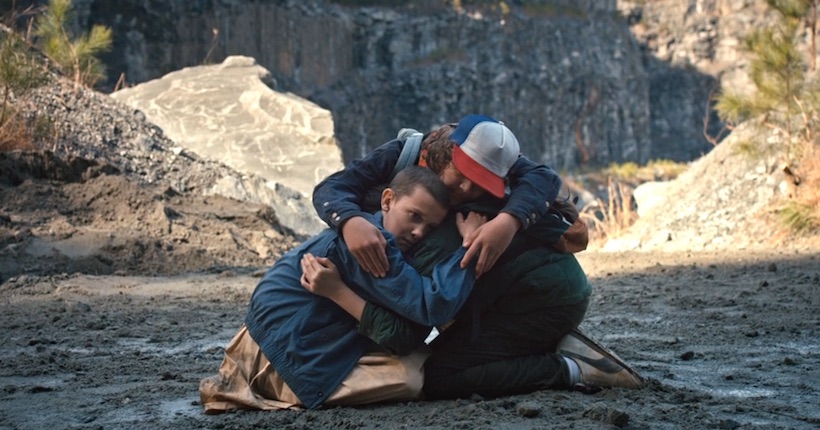
The nature of monsters implies that there must eventually be a confrontation against the horrors stalking the characters within a story. In science fiction, the confrontation with a monster has had a variety of outcome ranging from victory to defeat, or even a more murky middle ground. In James Cameron’s discussion within the episode, the director asserts that the prototypical monster stories required the human to defeat or kill the monster. While notable films like John Carpenter’s The Things (released in 1982) may end with the monster alive, these “counterculture ’70s and ’80s” films are often the outlier rather than the norm (Cameron, 169). In most monster stories, the story reaches a climax where the hero or protagonist must confront their fears and in doing so they “kill it [the monster]. The diverse science fiction genre has developed many different ways of combating the monster including conquering the monster “by ingenuity, by willpower, by courage, by bravery, by faith” (Cameron, 169). With this in mind, it is apt to examine the ultimate confrontation in Stranger Things and why this conflict is one of the most potent and powerful moments within the show.
For many critics and fans, part of the power of the Stranger Things relates to the involvement of young characters and their struggles to confront terrifying or difficult situations. In their interview for James Cameron’s Story of Science Fiction, Matt and Ross Duffer assert that many of their favorite stories growing up were stories involving children dealing with “a terror of some kind” (36:50). The struggles of children and childhood are not only a common influence for the show, but potentially a reason for some of the shows power and tension as well. Mark Steger, the creature artist for Stranger Things points out that human beings have developed a need to “protect the young”; an instinct that may be triggered when Will Byers, Barb Holland, and the other youths of Hawkins are threatened by the monster (39:20). Ars Technica‘s Annalee Newitz asserts that children are the ‘ultimate vulnerability” and the attack and/or loss of a child heightens the tension of the situations within the show. The interviews with Mark Steger and Annalee Newitz demonstrate that stories with youths can elicit an especially powerful reaction from viewers, heightening the tension and impact of powerful moments within a show such as Stranger Things.
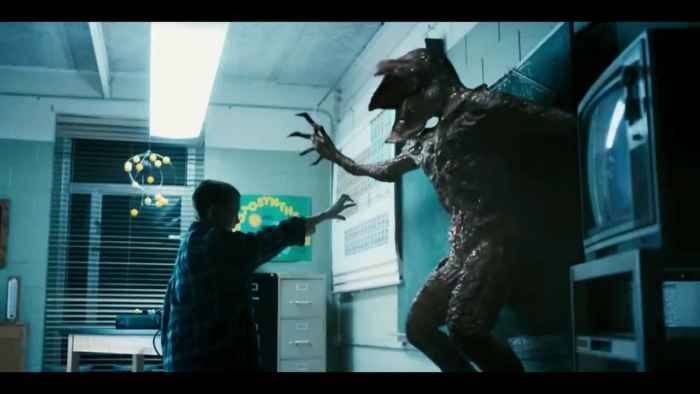
When viewing stories where children are battling monsters it is possible to see the struggle as a representation of the “passing from childhood to teen [adult]. Stranger Things (especially the recently released Season 3) involves a group of children confronting the challenges that come with growing up. While this may include science fiction monsters and life altering experiments; it also includes universal struggles like a fear of change and sense of confusion about the world around us. Critic Annalee Newitz reminds the viewer of James Cameron’s Story of Science Fiction that growing up can be a “horrific terrifying process” even within the confines of a relatively ordinary monster-less life (39:52). The transition from childhood to young adulthood is filled with trials and tribulations that challenge our understanding of the world as well as the way we fit into it. Many teenagers feel like outsiders within their once familiar society, similar to science fiction monsters who are shunned or feared in films, television, and books.
Another way to view the conflict with the monster as an “excising of demons/terrors” from a person’s life. Since many science fiction monsters represent the “dark parts of ourselves”, we can view the battle with monsters as a representation of our own internal struggles. Science fiction and horror are ways to explore our “angst and fantasies and our terrors…a nightmare that’s safe”. Stories are comfortable, perhaps even appropriate ways for human beings to express or ruminate on the darker aspects of our nature. Whether it is mental illness, disease, racism, violence, or some other terrible or powerful force, the monster can be used to represent these all too real forces. The defeat of the monster can represent an internal or external triumph over the force that have haunted the character.
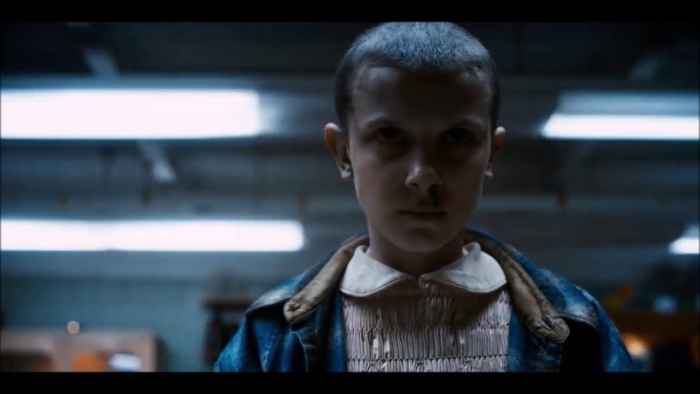 While there are many wonderful characters introduced in Stranger Thing Season 1, Eleven emerged as one of the most iconic and most important character in the show. Much of Season 1 is about Eleven learning what it means to be human. Mike, Dustin, Lucas, and the other characters that Eleven encounters teach her with mottos like “friends don’t lie” and show her compassion despite her differences. While Brenner wants to exploit her unique powers and gifts, the others marvel at her abilities. If we perceive Eleven and the Demogorgon as monsters that are the result of Dr. Brenner’s behaviors, we see a final confrontation in which Eleven is reclaiming parts of her humanity by protecting Mike, Dustin, and Lucas from the Demogorgon. While the Demogorgon could represent the Hawkin’s experiments taken to their extreme, creating a monster without humanity or morality, Eleven’s arc within the first season is about a character who embraces the human connections she had made. Eleven is willing to defend her new life with fierce intensity and slaying some of her own inner demons in the process. Eleven defeats the Demogorgon, overcoming the damage and evil that Dr. Brenner has committed.
While there are many wonderful characters introduced in Stranger Thing Season 1, Eleven emerged as one of the most iconic and most important character in the show. Much of Season 1 is about Eleven learning what it means to be human. Mike, Dustin, Lucas, and the other characters that Eleven encounters teach her with mottos like “friends don’t lie” and show her compassion despite her differences. While Brenner wants to exploit her unique powers and gifts, the others marvel at her abilities. If we perceive Eleven and the Demogorgon as monsters that are the result of Dr. Brenner’s behaviors, we see a final confrontation in which Eleven is reclaiming parts of her humanity by protecting Mike, Dustin, and Lucas from the Demogorgon. While the Demogorgon could represent the Hawkin’s experiments taken to their extreme, creating a monster without humanity or morality, Eleven’s arc within the first season is about a character who embraces the human connections she had made. Eleven is willing to defend her new life with fierce intensity and slaying some of her own inner demons in the process. Eleven defeats the Demogorgon, overcoming the damage and evil that Dr. Brenner has committed.
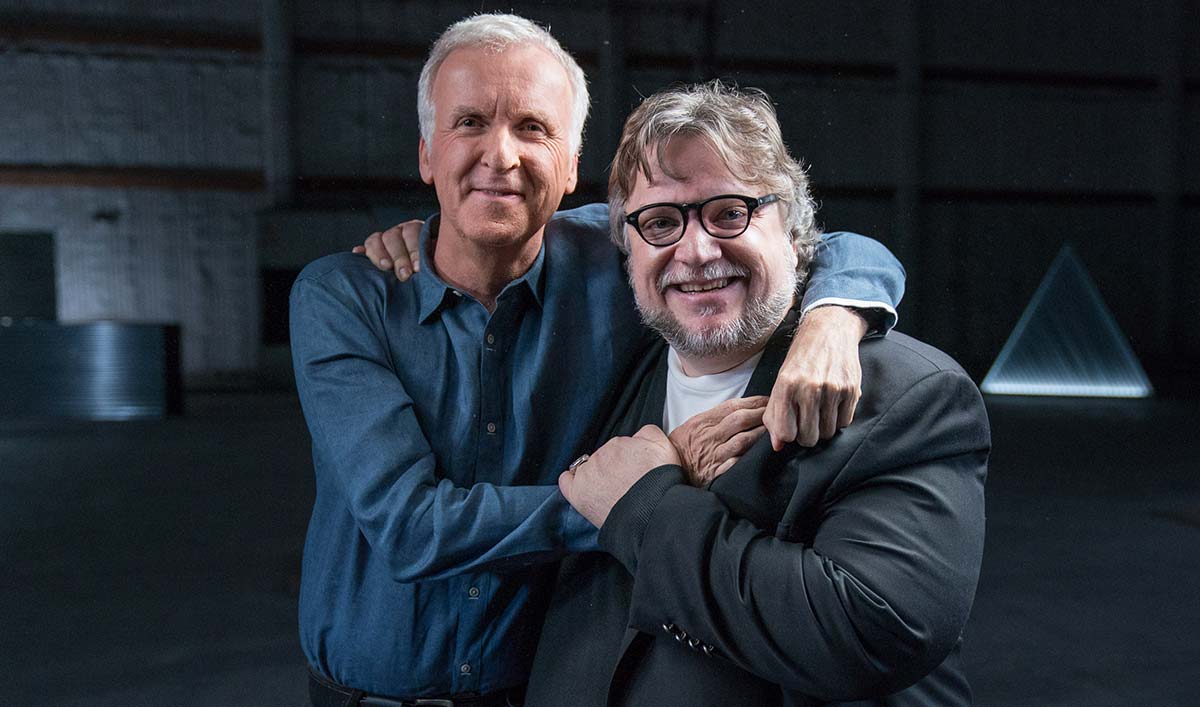
While exploring the influences of Stranger Things using James Cameron’s Story of Science Fiction may eliminate some of mystery surrounding the series, the interviews within Cameron’s show provide keen insight into how the show is constructed, as well as some of the reasons for its phenomenal success. The creators, writers, production designers of Stranger Things show their keen insight into the long history of science fiction that came before them. By understanding, using, and subverting the traditions and influences of other science fiction stories, Stranger Things is capable of creating a show that fills the audiences with memories for years to come.
Work Cited
https://www.chaosgroup.com/blog/aaron-sims-creative-making-a-monster-for-stranger-things
Cameron, James, et al. James Cameron;s Story of Science Fiction. Insight Editions, 2018.
Duffer, Matt, Ross Duffer, Winona Ryder, David Harbour, Finn Wolfhard, Millie B. Brown, Gaten Matarazzo, Caleb McLaughlin, Natalia Dyer, Charlie Heaton, Cara Buono, and Matthew Modine. Stranger Things: Season 1. , 2017.
“James Cameron’s Story of Science Fiction/Monsters.” Season 1, Episode 3, AMC, 14 May 2018.
What do you think? Leave a comment.
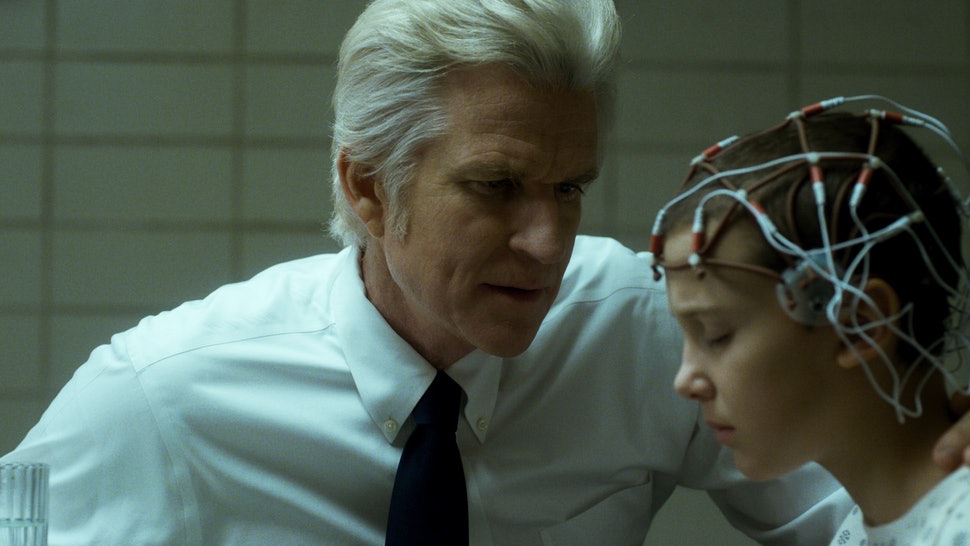
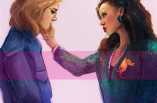
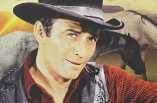
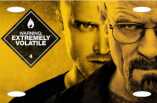

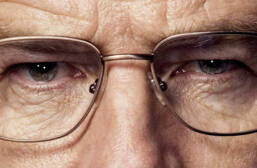
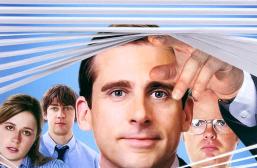

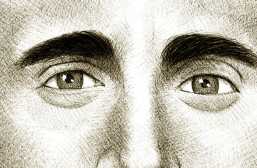
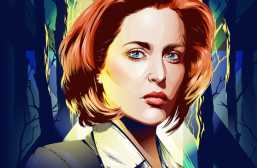
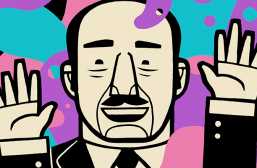
Great article. I love the concept of audiences vicariously learning to confront their fears through the kids’ confrontation of monsters. It helps explain why so many adults enjoy Stranger Things despite the focus on young characters! Sometimes we just need encouragement to face the frightening things in our lives, whether they’re Demagorgons or really scary utility bills.
What an insightful article! The exploration of Eleven as a kind of monster as she simultaneously fights monsters is really intriguing. I think it’s really interesting how young girls are positioned in current pop culture as such a source of anxiety for adults, particularly men – think Laura from ‘Logan’ or Ellie from the recent remake of ‘Pet Sematary’. I wonder if audience reception to these young girls in media has any relation to ‘real life’ threats of exceptional young women – just look at what is going on in real life currently with Greta Thunberg!
Quality article, insightful and well written.
I wasn’t a huge fan of Stranger Things for its derivative, Spielbergian homage (The Goonies), plus the Hollywoodized trop of pitting pubescent youths against the supernatural; however, this article underscores the aspects of Stranger Things I appreciated, and even modified my interpretation a little. Kudos, Sean.
The first episode of the third season was perfection. I’ve not seen anything as fun as that since E.T. was dressed up as a ghost.
I enjoyed it a lot more than season two and thought the pace was spot one. Very little filler, all killer so to speak.
Compared to one of those bloated Marvel shows that run for 13 episode Stranger Things looks positively lean….
The chemistry between the children is fantastic.
The young actors and actresses are fantastic and really make the show special.
Graet analysis. Feels like the next season cannot be about the demagogue/mindflayer again.
Like all successful American series they never know when to end it – money talks. Series one was incredible, series two was mediocre and this one is just appalling. Instead of giving this a kick by taking us back to what made the first series good (like True Detective did) they’ve gone down the ponderous “look at the acting range of so and so”. Nobody cares. We want action not teenage angst drama.
You didn’t watch it, did you?
A major part of the appeal of Stranger Things, for me at least, was always the character relationships – the constant back and forth between the boys, and as S2 progressed, the developing friendship between Steve and Dustin. Series 3 is really just the Duffer Bros giving us more of that. Let’s face it, the plot is absurd – an enormous Russian bunker built underneath a suburban American mall? Come on! – but it’s really just the backdrop against which we can watch our favourite characters be our favourite characters.
It’s fun. Maybe not the deepest, but who cares?
Like bathing in nostalgia.
Part of the joy of Stranger Things is the nostalgia, the references. The mayor working against the people of the town for his own benefit (Jaws), the renegade policeman (Magnum), the direct Romero references throughout, the body horror of The Thing. The emotional heft comes in the last few eps as we see everything we’ve had built up over the series come to a head, the emotional growth. Does Hopper’s final letter have the impact it would without us seeing Mike and Eleven’s growing pains and relationship. Would Will moving on have such meaning without seeing his breakdown in episode 3, he was the lost child in previous seasons, and again, just as he’s re-establishing himself in his previous life, his pals are moving on. It was beautifully done and I didn’t find it dragging at all.
It’s a great feeling when you catch a reference. My favourite this series was when Hopper was fighting the Russian bad guy and they were both framed in fighting stances (guards up) in shadow against the spinning propellers of the gun-blaster-thing behind them. If that’s not a Street Fighter reference, I’ll eat my hat.
Thomas Sullivan Magnum IV was not a cop, renegade or otherwise.
My Goddaughter recommended this show. I loved the first series, I am finding the second (I am at episode 6) nullyfyingly boring, repetitive, and claustrophobic.
2nd series was booooring . Third series is the polar opposite , it’s fantastic !
I started watching Stranger Things a few days ago, after all the rave reviews it’s been getting in the press, and have to admit that I don’t understand what all the fuss is about: I gave up halfway through the fourth episode. Above all, the kids are unbearably irritating.
But we can’t all enjoy everything, and I’m sure there are programmes I love that everyone else hates.
Just to clarify, do you mean season 1 or this season?
If you started watching this season, maybe go back and look at season 1 first. But if you’ve done that and didn’t like it, well, tastes differ, I guess. To me a large part of the fuss is the incredible detail they’ve gone into in recreating the 80s. I mean, it’s not just the clothes and hairstyles and so on but all the cultural references which I thought I’d forgotten. But, I guess, you have to be old enough to remember them to appreciate that.
I feel that the interplay between characters is too drawn out. I could do without Joyce and Hopper’s ranting and raving, and feel like most of the cast have become caricatures of themselves. It’s almost as though the plot itself is playing second fiddle to the building of the characters’ personalities.
I feel that the interplay between characters is too drawn out. I could do without Joyce and Hopper’s ranting and raving, and feel like most of the cast have become caricatures of themselves. It’s almost as though the plot itself is playing second fiddle to the building of the characters’ personalities.
The strengths in Stranger Things, for me, included the bits that some people found boring: the child characters growing up and apart, with their different interests. Hopper trying not to be freaked out by his adopted teenage daughter having a boy in the house. Steve and Dustin’s bromance. These all added to the character development and I found the episodes very enjoyable, especially the quiet moments.
The first and second episode of Stranger Things seasons are always exciting for me because I also love the more normal aspects of their lives (though I do love the rest of the show).While Season 3 had its issues for me, I loved seeing the characters go to Starcourt (especially Max and El) and the entire writing about the “talk” with hopper and joyce was fun and human. Hopper’s “dad” moments and interactions with El and Mike were awkwardly funny in such an authentic way. I would love for Stranger Things to do like a “special” episode where it is just the characters going through their day and allowing the viewer the “shenanigans” that they could get up to without monsters. Maybe like a special Christmas episode or something like that.
I feel like the mystery element has vanished completely, since at this point we all no it’s the same monster again behind all spooky stuff in Hawkins (it has always bothered me that it was just a monster with no real back story or concept to begin with.)
Also the Russians were just bland stereotypes and extremely uniteresting.
I thought it was very much a nod to how Russians were portrayed in Cold War era films – think Ivan Drago or the huge blond bloke from ‘From Russia with Love’.
A good article and I enjoy “Stranger Things” looking forward to the next season.
I’ve been loving this series. The comedy, the relationship building, coupled with the horror shocks and all the throwback set pieces to all the films of my youth, I love it!
Hopper lives.. yay! Bring on 4 and dont trust anyone over 20…
This was a really good article. It provided a different lens to view the show through, which makes me want to go back and rewatch it. Which is good because I just finished the 3rd season. I want to go back and see what other references to blockbusters I missed. I never put together the Jaws thing, although that’s not surprising given the intensity of those scenes.
I really enjoyed this article, so thank you! I loved reading about the references that can be found in the show… I want to go back and watch Stranger Things again now.
I didn’t enjoy the second season as much as the others, but overall it was a really interesting show to watch.
Thank you for looking into Cameron and Del Toro’s views on science fiction. I hadn’t previously read about these particular statements and found them insightful.
Such an interesting concept, although I definitely think it was executed much better in season 1 compared to 2 and 3. Hopefully the story in 4 makes more sense.
The concept of the spiritual monster has always fascinated me. I remember reading Bram Stoker’s Dracula and how Dracula is seen as such a threat to the hero’s way of life and values.
A fascinating look behind the scenes at a show I stumbled across, never expected to like, then enjoyed for three seasons. Of all seasons the first remains the most appealing mix of nostalgia, humour, mystery, engaging characterisation and action for me. Your insight into the design of the faceless Demogorgon was very interesting. Thank you.
Very cool analysis! I really enjoyed your perspective.
I’m really intrigued by the parallels between Eleven and the Demogorgon. In destroying the Demogorgon, Eleven rejects the “special world” of Dr. Brenner. In doing so she gains new friends, a new life in Hawkins and reclaims her own humanity by destroying her final tie to Brenner and the lab.
That is a great point! I think that is one of the reasons why season is so excellent. There is a deep connection between the Eleven, Demogorgon, and Brenner. This is part of why Eleven has the most dramatic and meaningful character arc within the first season..
One of the best sci-fi series I have seen. I don’t watch much sci-fi because it tends to come across as “silly,” or “unbelievable.” However, Stranger Things was hands down, neither of those. My favorite character was Eleven. Since the first episode of the first season, I think casting directors, film directors, and producers, found Millie Bobby Brown a good investment if you need a screamer. I would go so far as to say, she can out scream the original best screamer of all time, Jamie Lee Curtis. Notice they both use three names???
In the section Battling The Monster – Why Stranger Things And Their Young Characters Resonates So Strongly With Audiences…I thought the author might consider some of the nostalgic references to the 80’s – for me this is one of the most beautiful things about Stranger things. It plays on our memories or ideas of the time period in which it’s set.
Nice observation on the connection of monsters with the association with good and evil. This would be a rough working definition of physiognomy.